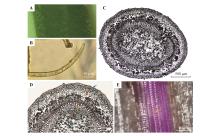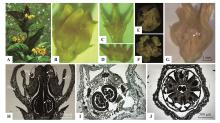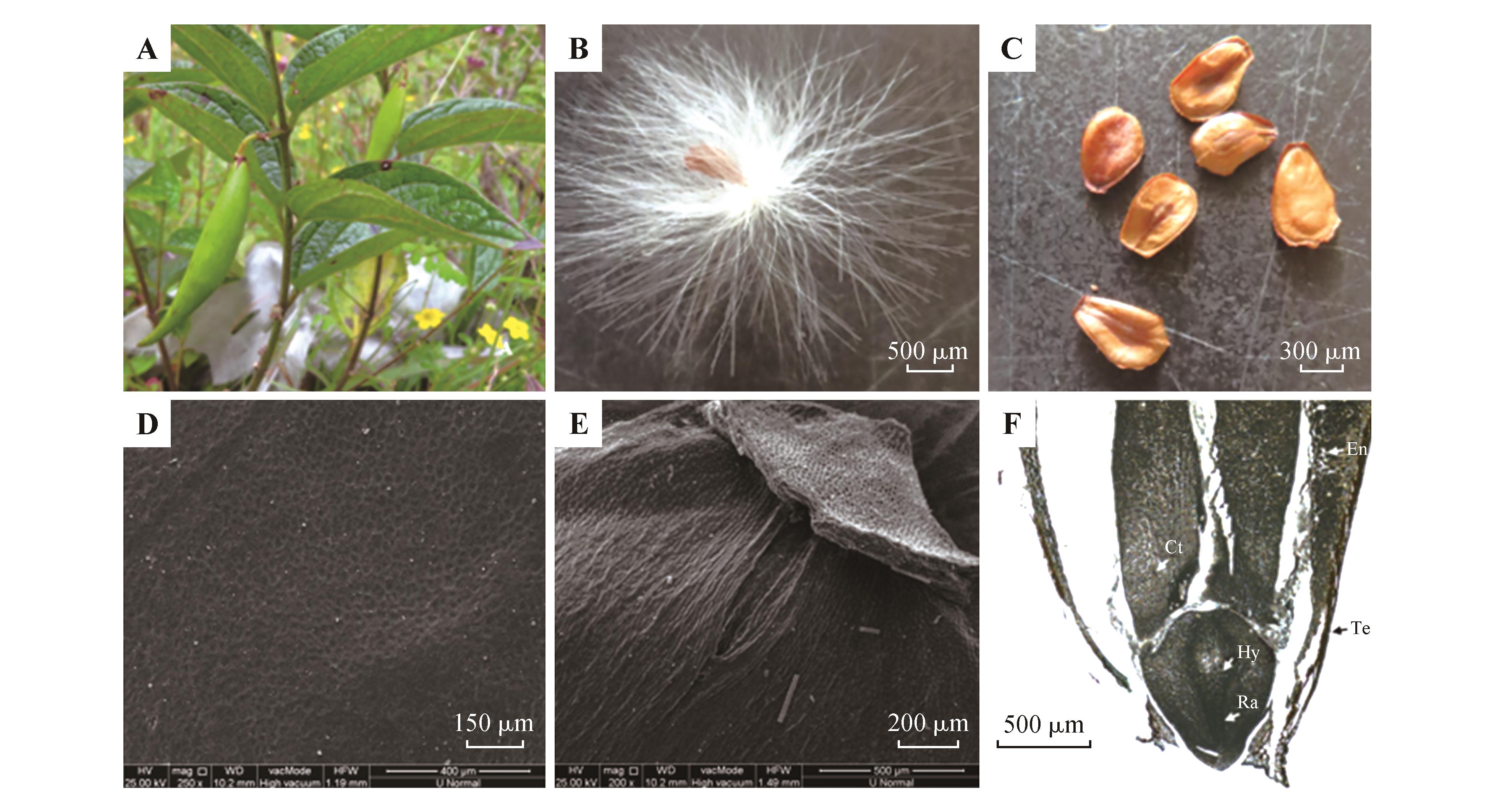Bulletin of Botanical Research ›› 2024, Vol. 44 ›› Issue (3): 389-399.doi: 10.7525/j.issn.1673-5102.2024.03.008
• Physiology and Ecology • Previous Articles Next Articles
Shuanglong TANG1, Shixin CHEN1, Yu WANG1, Danwei MA1( ), Shihui YANG2, Shenming NIE3, Zhaxizeli4, Zhengyou TIAN4
), Shihui YANG2, Shenming NIE3, Zhaxizeli4, Zhengyou TIAN4
Received:2023-09-01
Online:2024-05-20
Published:2024-05-14
Contact:
Danwei MA
E-mail:danwei10ma@126.com
CLC Number:
Shuanglong TANG, Shixin CHEN, Yu WANG, Danwei MA, Shihui YANG, Shenming NIE, Zhaxizeli, Zhengyou TIAN. Morphological Adaptation to Alpine Environment of a Chinese Endemic Species, Cynanchum forrestii[J]. Bulletin of Botanical Research, 2024, 44(3): 389-399.
Add to citation manager EndNote|Ris|BibTeX
URL: https://bbr.nefu.edu.cn/EN/10.7525/j.issn.1673-5102.2024.03.008

Fig.2
Distribution, microscopic and ultrastructure of leaf epidermal hair of C. forrestiiA,D.Appearance and distribution of epidermal hairs on the upper and lower epidermis of leaves;B,E.Microscopic images of the upper and lower epidermis hairs of the leaves;C,F.Scanning electron microscopy images of the lower epidermis.


Fig.4
Surface morphological and microscopic structure of the stem of C. forrestiiA.External morphology of the stem;B.Epidermal hair structure of the stem;C-D.Cross-sections of the stem;E.Longitudinal section of the stem;The blue arrow represented the epidermis;The red arrow represented the cortex;The yellow arrow indicated the catheter;Light blue arrows indicated marrow.


Fig.6
Mophological and microstructure of flower of C. forrestiiA.Inflorescence;B.Flower shape;C.Calyx;D.Corolla;E.Corona;F.Gynostegium;G.Longitudinal cutting of flower;H.The longitudinal section of flowers;I,J.The cross section of flower;Pe.Petal; St.Stigma;Gy.Gynandrium;Cr.Corona;Ov.Ovary;Po.Pollinia;Fi.Filament.


Fig.8
Appearance, surface sub-microstructure and longitudinal section microstructure of fruit and seed of C. forrestiiA.Fruit;B.Seed with hairs;C.Seed;E-F.Scanning electron microscopy images of the seed surface;G.Microscopic view of seed longitudinal section;Te.Testa;Ct.Cotyledons;En.Endosperm;Hy.Hypocotyl;Ra.Radical;Hi.Hilum.

| 1 | 陈时鑫,张伟,马丹炜,等.高寒条件下根际环境对极小种群大理白前竞争能力的影响[J].生态学报,2023,43(6):2555-2567. |
| CHEN S X, ZHANG W, MA D W,et al.Effects of rhizosphere environment on the competitive ability of extremely small population of Cynanchum forrestii Schltr under alpine conditions[J].Acta Ecologica Sinica,2023,43(6):2555-2567. | |
| 2 | 李全发,王宝娟,安丽华,等.青藏高原草地植物叶解剖特征[J].生态学报,2013,33(7):2062-2070. |
| LI Q F, WANG B J, AN L H,et al.Leaf anatomical characteristics of the plants of grasslands in the Tibetan Plateau[J].Acta Ecologica Sinica,2013,33(7):2062-2070. | |
| 3 | 施征,白登忠,雷静品,等.高山植物对其环境的生理生态适应性研究进展[J].西北植物学报,2011,31(8):1711-1718. |
| SHI Z, BAI D Z, LEI J P,et al.Advance on physioecological adaptation of alpine plants to mountainous environment[J].Acta Botanica Boreali-Occidentalia Sinica,2011,31(8):1711-1718. | |
| 4 | 中国植物志编辑委员会.中国植物志:第63卷[M].北京:科学出版社,1977:335. |
| Compilation Committee of Flora of China.Flora of China:Vol.63[M].Beijing:Science Press,1977:335. | |
| 5 | 刘悦,刘静,庾石山,等.大理白前化学成分研究[J].中国中药杂志,2007,32(6):500-503. |
| LIU Y, LIU J, YU S S,et al.Studies on chemical constituents of Cynanchum forrestii [J].China Journal of Chinese Materia Medica,2007,32(6):500-503. | |
| 6 | 陈纪军,张壮鑫,周俊.大理白前的化学成分[J].云南植物研究,1989,11(4):471-475. |
| CHEN J J, ZHANG Z X, ZHOU J.The chemical constituents of Cynanchum forrestii [J].Acta Botanica Yunnanica,1989,11(4):471-475. | |
| 7 | 刘悦.大理白前化学成分及其生物活性研究大理白前中甾体苷类化学成分ESI-MS裂解行为研究[D].北京:中国协和医科大学,2006. |
| LIU Y.Studies on the constituents and bioactivity of Cynanchum forrestii studies on the ESL-MS fragmentation behavior of steroidalglycosides from Cynanchum forrestii [D].Beijing:China Union Medical University,2006. | |
| 8 | LIU Y, HU Y C, YU S S,et al.Steroidal glycosides from Cynanchum forrestii Schlechter[J].Steroids,2006,71(1):67-76. |
| 9 | LIU Y, QU J, YU S S,et al.Seven new steroidal glycosides from the roots of Cynanchum forrestii [J].Steroids,2007,72(4):313-322. |
| 10 | ZHANG J, ZHANG D Q.The complete chloroplast genome sequence of Cynanchum forrestii Schltr.(Asclepiadaceae) and its phylogenetic analysis[J].Mitochondrial DNA Part B,2019,4(2):3675-3676. |
| 11 | 苟占平,杨永建,马志刚,等.甘肃省鹅绒藤属4种药材原植物茎横切面组织构造比较[J].兰州医学院学报,2000(3):13-14. |
| GOU Z P, YANG Y J, MA Z G,et al.Comparative tissue structure of transections of 4 medicinal plants from Cynanchum in Gansu Province[J].Journal of Lanzhou Medical College,2000(3):13-14. | |
| 12 | 李玉玲,秦新生,冯乙晴.12种鹅绒藤属(萝藦科)植物花粉器形态学研究[J].植物研究,2012,32(2):137-142. |
| LI Y L, QIN X S, FENG Y Q.Pollinarium morphology of 12 species of Cynanchum(Asclepiadaceae)[J].Bulletin of Botanical Research,2012,32(2):137-142. | |
| 13 | 洪文君,郭成龙,秦新生,等.9种鹅绒藤属(萝藦科)植物种子微形态特征研究[J].西南农业学报,2014,27(2):797-800. |
| HONG W J, GUO C L, QIN X S,et al.Seed micromorphology of 9 species of Cynanchum(Asclepiadaceae)[J].Southwest China Journal of Agricultural Sciences,2014,27(2):797-800. | |
| 14 | 洪文君,阙青敏,秦新生.中国鹅绒藤属(萝藦科)植物叶表皮微形态扫描电镜研究[J].西南农业学报,2013,26(2):742-749. |
| HONG W J, QUE Q M, QIN X S.Studies on micromorphology of leaf epidermis of Cynanchum(Asclepiadaceae) from China under environmental Scanning Electron Microscope[J].Southwest China Journal of Agricultural Sciences,2013,26(2):742-749. | |
| 15 | 徐秀苹,孟淑春,冯旻.一种快速、简易的扫描电镜植物样品干燥新方法[J].中国细胞生物学学报,2017,39(2):203-206. |
| XU X Y, MENG S C, FENG M.New method on scanning electron microscopy(SEM) samples drying[J].Chinese Journal of Cell Biology,2017,39(2):203-206. | |
| 16 | 张志良,瞿伟菁.植物生理学实验指导[M].第3版.北京:高等教育出版社,2003. |
| ZHANG Z L, QU W Q.The guidance of plant physiology experiments[M].3nd ed.Beijing:Higher Education Press,2003. | |
| 17 | 杨继,汪小凡.植物生物学实验[M].2版.北京:高等教育出版社,2007. |
| YANG J, WANG X F.Experiment of plant biology[M].2nd ed.Beijing:Higher Education Press,2007. | |
| 18 | 沈宁东,韦梅琴,李宗仁,等.高寒地区不同海拔藏茴香茎解剖结构比较研究[J].广西植物,2015,35(2):194-199. |
| SHEN N D, WEI M Q, LI Z R,et al.Comparative study about the anatomical structure for stem of Carum carvi in different elevations of alpine-cold area[J].Guihaia,2015,35(2):194-199. | |
| 19 | 陈小红,徐扬,刘韩,等.川西高原4种高山海棠的根茎解剖结构特征及其抗旱响应策略分析[J].西北植物学报,2017,37(7):1296-1302. |
| CHEN X H, XU Y, LIU H,et al.Root/stem anatomical characteristics of four Malus plants in western Sichuan Plateau and their drought adaptation strategy[J].Acta Botanica Boreali-Occidentalia Sinica,2017,37(7):1296-1302. | |
| 20 | 韩雨圳,陈凤林,杨春娇,等.高寒草甸矮生嵩草不同根序解剖结构对生境干旱化的响应[J/OL].生态学杂志,(2022-10-19)[2023-10-05].. |
| HAN Y C, CHEN F L, YANG C J,et al.Response of anatomical structures of different root orders of Kobresia humilis to habitat aridification in an alpine meadow[J/OL].Chinese Journal of Ecology,(2022-10-19)[2023-10-05].. | |
| 21 | 刘雄盛,肖玉菲,王勇,等.江南油杉营养器官的解剖结构及其生态适应性[J].植物科学学报,2020,38(1):39-46. |
| LIU X S, XIAO Y F, WANG Y,et al.Anatomical structures of vegetative organs of Keteleeria fortunei(Murr.) Carr.var.cyclolepis(Flous) Silba and its ecological adaptability[J].Plant Science Journal,2020,38(1):39-46. | |
| 22 | 贾傲,郑梦娜,陈之光,等.青藏高原雪白委陵菜(Potentilla nivea)叶片性状对海拔的响应[J].生态学杂志,2023,42(4):769-779. |
| JIA A, ZHENG M N, CHEN Z G,et al.Altitudinal variations of leaf traits of Potentilla nivea in the Qinghai-Tibet Plateau[J].Chinese Journal of Ecology,2023,42(4):769-779. | |
| 23 | 罗广令,廖海民,胡国雄.唇形科苣叶鼠尾草和岩生鼠尾草营养器官的比较解剖结构及其生态适应性[J].植物科学学报,2022,40(5):598-609. |
| LUO G L, LIAO H M, HU G X.Anatomical structures of vegetative organs of Salvia sonchifolia C.Y.Wu and S.petrophila G.X.Hu,E.D.Liu & Yan Liu(Lamiaceae) and their ecological adaptability[J].Plant Science Journal,2022,40(5):598-609. | |
| 24 | 郭文文,卓么草,周尧治.西藏高原硬叶柳叶片结构对寒旱环境的适应机制[J].西北植物学报,2019,39(5):784-790. |
| GUO W W, ZHUO M C, ZHOU Y Z,et al.The Salix sclerophylla leaves to adapt to the cold and drought environment on the Tibetan plateau[J].Acta Botanica Boreali-Occidentalia Sinica,2019,39(5):784-790. | |
| 25 | 韩金凤,夏天,刘一华,等.基因调控植物表皮毛发育的研究进展[J].植物生理学报,2023,59(8):1517-1523. |
| HAN J F, XIA T, LIU Y H,et al.Research progress on gene regulation of plant trichome development[J].Plant Physiology Journal,2023,59(8):1517-1523. | |
| 26 | 刘堡森,毛跃雄,王秀荣,等.棕榈花发育形态和解剖结构[J].植物生理学报,2023,59(3):569-578. |
| LIU B S, MAO Y X, WANG X R,et al.Morphological and anatomical structure of Chinese windmill palm(Trachycarpus fortunei) flowers during development[J].Plant Physiology Journal,2023,59(3):569-578. | |
| 27 | SONG B, ZHANG Z Q, STÖCKLIN J,et al.Multifunctional bracts enhance plant fitness during flowering and seed development in Rheum nobile(Polygonaceae),a giant herb endemic to the high Himalayas[J].Oecologia,2013,172(2):359-370. |
| [1] | LIU Min-Xia, LI Li-Rong, CHE Ying-Di, JIAO Jiao. Functional Traits of Plant Leaves at Different Succession Stages in Alpine Meadow [J]. Bulletin of Botanical Research, 2019, 39(5): 760-769. |
| [2] | XU Yang, CHEN Xiao-Hong, LI Hui-Min, DING Yin-Peng, KANG Xi-Kun, LI Qian. Anatomical Characteristics of Vegetative Organs of Two Alpine Crabapples and Their Ecological Adaptation [J]. Bulletin of Botanical Research, 2016, 36(5): 660-668. |
| [3] | MA Yong-Hong. Leaf Dvelopment and Its Ecological Adaptability of Cercidiphyllum japonicum [J]. Bulletin of Botanical Research, 2016, 36(5): 705-711. |
| [4] | YANG Mei-Ling;YAN Xiu-Na;YU Wei-Wei;LONG Hong;YAN Guo-Rong*. Characteristics of Leaf Anatomical Structure of Malus sieversii in Different Geographical Distribution and Plant Age [J]. Bulletin of Botanical Research, 2015, 35(4): 509-514. |
| [5] | LI Guo-Xiu;ZHENG Bao-Jiang*. Comparative Study on Morphological Characteristics and Ecological Adaptability of Vessel Elements of Ten Ribes L. Varieties [J]. Bulletin of Botanical Research, 2014, 34(1): 25-31. |
| [6] | SHI Fu-Sun;CHE Hua-Feng;WU Ning*. Effect of Experimental Warming on Carbon and Nitrogen Content of Sub-alpine Meadow in Northwestern Sichuan [J]. Bulletin of Botanical Research, 2008, 28(6): 730-736. |
| [7] | ZHANG Xing-Wang;ZHANG Xiao-Ping*;YANG Kai-Jun;ZHANG Zhong-Xin. Study on Anatomical Structure of Leaf and Ecological Adaptability ofPterocektis tartarinowii Maxim [J]. Bulletin of Botanical Research, 2007, 27(1): 38-42. |
| [8] | Chang Zhao-yang, Zhang Ming-li. ANATOMICAL STRUCTURES OF YOUNG STEMS AND LEAVES OF SOME CARAGANA SPECIES WITH THEIR ECOLOGICAL ADAPTABILITIES [J]. Bulletin of Botanical Research, 1997, 17(1): 65-71. |
| Viewed | ||||||
|
Full text |
|
|||||
|
Abstract |
|
|||||